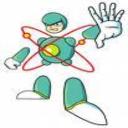Yahoo Answers is shutting down on May 4th, 2021 (Eastern Time) and beginning April 20th, 2021 (Eastern Time) the Yahoo Answers website will be in read-only mode. There will be no changes to other Yahoo properties or services, or your Yahoo account. You can find more information about the Yahoo Answers shutdown and how to download your data on this help page.
Trending News
A2 Physics Question (Mechanics/Circular Motion)?
I have been given a question to answer but I have no idea where to begin, I would appreciate it if someone could explain how to do it, what equations to use in what order etc... without actually putting the numbers into the equations. Thanks in advance.
A plane of mass 4000 kg is travelling in a level circle. In order to do this it is banked at 5 degrees to the horizontal, if the plane has a velocity of 100 ms^-1 what is the radius if the circle?
3 Answers
- KnowallLv 51 decade agoFavorite Answer
Let the total lift generated be L.
As it is banking 5 degrees, Lcos5 is supporting its weight and Lsin5 is taking care of its centrifugal force.
To find lift L:
LCos 5= 4000*9.8=39,200N
L= 39200/Cos 5deg.= 39340N.
Now acceleration due rotation at constant speed is V^2/R where V is linear velocity and R is radius.
Hence centrifugal force generated = F=mass*acceleration= 4000*(100)^2/R
This is balanced by Lsin 5=3430N=4000*10000/R.
Hence R=4000*10000/3430 =11.66Km.
- electron1Lv 71 decade ago
A plane of mass 4000 kg is travelling in a level circle. In order to do this it is banked at 5 degrees to the horizontal, if the plane has a velocity of 100 ms^-1 what is the radius if the circle?
The force that causes an object to move in a circle is called centripetal force. This force pulls the object toward the center of the circle.
Force centripetal = mass * (velocity^2) ÷ radius
Fc = (m * v^2) /r
The plane has 2 forces acting on it.
The weight is pulling down and the force caused by the air pressure is pushing the plane up.
The plane is flying in a level circle, which means the plane is not moving down or up. So these 2 forces must be equal, but in opposite directions.
As the plane flies at a velocity of 100 m/s at an angle of 5º to the horizontal, the plane exerts a force on the air. This force is perpendicular to the bottom surface of the wings.
To visualize this force, I advise you to draw the picture that I will describe below!! If you have a protractor and a ruler your picture will be more accurate. You will have many problems in physics that are easier to understand by looking at picture!!
Draw a 6 cm horizontal line.
Label the left end as Point A and the right end as Point B
Measure 3 cm from Point A, and label the center of line AB as Point O.
Draw a 6 cm vertical line centered at Point O. Label top end as Point C and the bottom end as Point D
These 2 perpendicular lines are the coordinate axis for this problem. Point O is the origin.
Imagine rotating Line AB 5º counter clockwise around Point O.
The next line represents angle of the wings of the plane.
Draw a 6 cm line centered at Point O, but 5º counter clockwise from Line AB. Label the lower left end as Point E, and the upper right end as Point F.
Line EF represents the wings of the plane!!!
The force of the wings on the air is perpendicular to the bottom surface of the wings.
Draw a 6 cm line centered at Point O, but 95º counter clockwise from Line AB. Label the upper left end as Point G, and the lower right end as Point H.
Line GH represents the direction of the force that the wings exert on the air.
The force that the wings exert on the air is the lower right half of Line GH. Draw an arrow head pointing down and right at Point H
The arrow OH represents the force of the wings on the air. Angle BOH = 85º
Newton/s 3rd Law states that every force is accompanied by an equal and opposite force.
The force that the air exerts on the wings is the upper left half of Line GH. Draw an arrow head pointing up and left at Point G
The arrow OG represents the force of the wings on the air. Angle AOG = 85º
The force that the air exerts on the wings pushes the wings and the rest of the plane vertically up and horizontally to the left.
The vertical component = F * sin 85º
The vertical component must equal the weight of the plane.
Weight = mass * 9.8
Weight = 4000 * 9.8 = 39,200 N
F * sin 85º = 39,200 N
F = 39,350 N
The horizontal component = F * cos 85º
The horizontal component = 39,350 * cos 85º
The horizontal component = 3430 N
The horizontal component is the force that causes the plane to fly in a horizontal circle!!
Fc = (m * v^2) /r
3430 = (4000 * 100^2) /r
3430 * r = (4000 * 100^2)
r = (4000 * 100^2) ÷ 3430 = 11,662 m
- Anonymous1 decade ago
Answer --> 11,651 m
Values:
m = 4,000 kg
θ = 5°
v = 100 m/s
g = 9.81 m/s^2
In this instance where no friction is given, mass doesn't matter.
r = v^2 / [ g * tanθ ]
r = (100 m/s)^2 / [ (9.81 m/s^2) * tan(5) ]
r = (10,000 m^2/s^2) / [ (9.81 m/s^2) * (8.75E-2) ]
r = (10,000 m^2/s^2) / [ 0.858 m/s^2 ]
r = 11,651 m
Source(s): Engineering geologist and physicist





